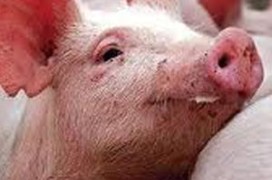The reduced ethanol production in the United States may have an unpleasant price effect for US swine producers as prices for Distillers Dried Grains and Solubles (DDGS) may rise as well.
 DDGS, a co-product from ethanol production, have become known as alternative and cost-reducing ingredients for swine diets since alternative energy sources for fossil fuels have been promoted. In the US, fuel mixtures have been sold containing both gasoline and ethanol.
DDGS, a co-product from ethanol production, have become known as alternative and cost-reducing ingredients for swine diets since alternative energy sources for fossil fuels have been promoted. In the US, fuel mixtures have been sold containing both gasoline and ethanol.
In his blog on the website of the Agricultural Marketing Resource Center, Iowa State University economist Dr Robert Wisner, professor emeritus, writes that DDGS production by ethanol plants is expected to show a decline in 2012, due to drought, a function of higher corn prices, but also because demand for gasoline has declined.
Exceeding prices
The price of DDGS, usually lower than corn, has come close to those of corn and soybean meal – and is known to have exceeded these as well. Wisner writes: “Record or near-record high soybean meal prices likely have allowed DDGS prices at times to exceed corn prices as the market more closely reflected their protein value.”
Wisner added that DDGS production will also feel the effects of any change in policy that reduces ethanol production, as well as from ethanol imported from Brazil.
Wisner said that the need for an additional income stream, “many ethanol plants have installed technology to remove corn oil” from DDGS – and more plants are likely to do so. This may have an impact on the quality of the DDGS, he said, adding that “there is an increased need for nutritional research to find optimum ways of using this modified DGS most effectively.”
He expects the production of decline to be temporary.
Related websites:
Iowa State University (ISU)
Agricultural Marketing Resource Center

In his blog on the website of the Agricultural Marketing Resource Center, Iowa State University economist Dr Robert Wisner, professor emeritus, writes that DDGS production by ethanol plants is expected to show a decline in 2012, due to drought, a function of higher corn prices, but also because demand for gasoline has declined.
Exceeding prices
The price of DDGS, usually lower than corn, has come close to those of corn and soybean meal – and is known to have exceeded these as well. Wisner writes: “Record or near-record high soybean meal prices likely have allowed DDGS prices at times to exceed corn prices as the market more closely reflected their protein value.”
Wisner added that DDGS production will also feel the effects of any change in policy that reduces ethanol production, as well as from ethanol imported from Brazil.
Wisner said that the need for an additional income stream, “many ethanol plants have installed technology to remove corn oil” from DDGS – and more plants are likely to do so. This may have an impact on the quality of the DDGS, he said, adding that “there is an increased need for nutritional research to find optimum ways of using this modified DGS most effectively.”
He expects the production of decline to be temporary.
Related websites:
Iowa State University (ISU)
Agricultural Marketing Resource Center



